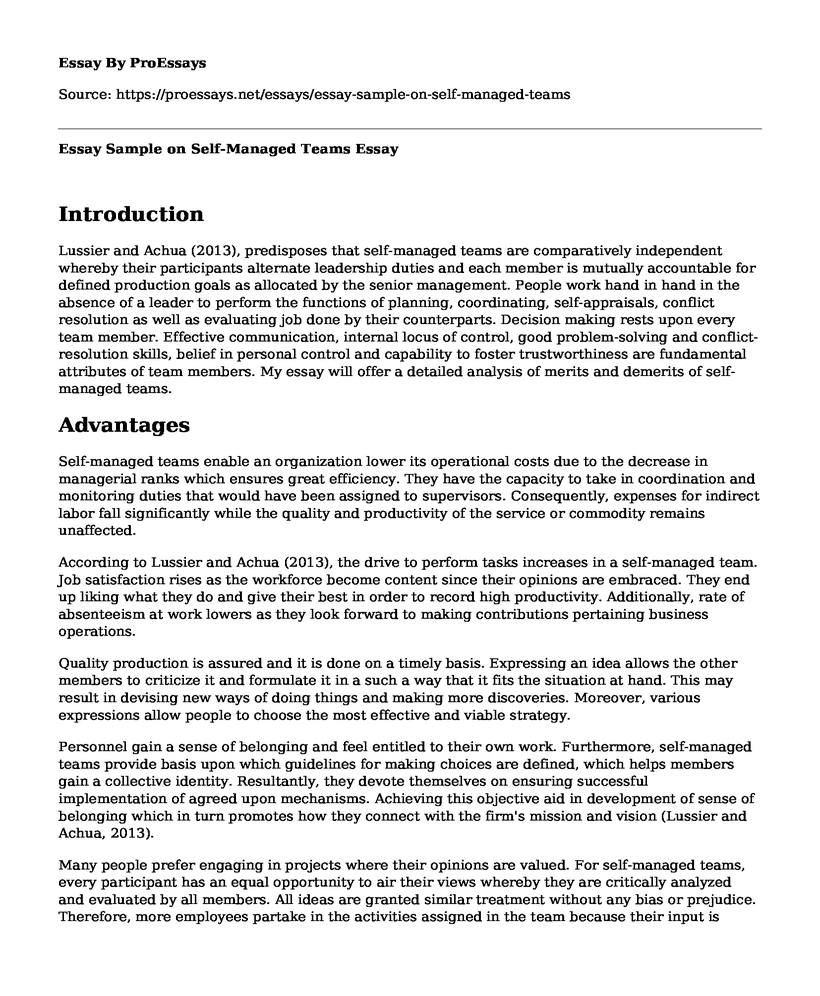Introduction
Lussier and Achua (2013), predisposes that self-managed teams are comparatively independent whereby their participants alternate leadership duties and each member is mutually accountable for defined production goals as allocated by the senior management. People work hand in hand in the absence of a leader to perform the functions of planning, coordinating, self-appraisals, conflict resolution as well as evaluating job done by their counterparts. Decision making rests upon every team member. Effective communication, internal locus of control, good problem-solving and conflict-resolution skills, belief in personal control and capability to foster trustworthiness are fundamental attributes of team members. My essay will offer a detailed analysis of merits and demerits of self-managed teams.
Advantages
Self-managed teams enable an organization lower its operational costs due to the decrease in managerial ranks which ensures great efficiency. They have the capacity to take in coordination and monitoring duties that would have been assigned to supervisors. Consequently, expenses for indirect labor fall significantly while the quality and productivity of the service or commodity remains unaffected.
According to Lussier and Achua (2013), the drive to perform tasks increases in a self-managed team. Job satisfaction rises as the workforce become content since their opinions are embraced. They end up liking what they do and give their best in order to record high productivity. Additionally, rate of absenteeism at work lowers as they look forward to making contributions pertaining business operations.
Quality production is assured and it is done on a timely basis. Expressing an idea allows the other members to criticize it and formulate it in a such a way that it fits the situation at hand. This may result in devising new ways of doing things and making more discoveries. Moreover, various expressions allow people to choose the most effective and viable strategy.
Personnel gain a sense of belonging and feel entitled to their own work. Furthermore, self-managed teams provide basis upon which guidelines for making choices are defined, which helps members gain a collective identity. Resultantly, they devote themselves on ensuring successful implementation of agreed upon mechanisms. Achieving this objective aid in development of sense of belonging which in turn promotes how they connect with the firm's mission and vision (Lussier and Achua, 2013).
Many people prefer engaging in projects where their opinions are valued. For self-managed teams, every participant has an equal opportunity to air their views whereby they are critically analyzed and evaluated by all members. All ideas are granted similar treatment without any bias or prejudice. Therefore, more employees partake in the activities assigned in the team because their input is regarded highly.
Disadvantages
Self-management teams are an ineffective mechanism when employed in restructuring work in a company because it does not deliver positive and favorable results. It stems from the fact that more commitment and effort is required from the top management and all members.
Social loafing adversely affects effectiveness of these teams. Certain members may slack in performing their allocated duties in cases where they are not clearly stated. They loaf and expect other participants to chip in. However, the trend takes effect on others who will not be willing to carry the lazy party's burden whereby they too lessen their efforts. Total output of firm will definitely fall due to poor execution of duties.
Group thinking is another demerit associated to self-managed teams. Specific members may always disregard views that are against the topic of discussion. The team ends up failing due to its alignment on one side and lack of projecting strategies of tackling future challenges. When people follow the designed form of decision making, they may lose their individuality because they lack a chance to express their ideas. Furthermore, the organization may lack diversification which may affect the morale of workers due to doing the same things always.
Conclusion
Self-managed teams are gaining a wide acceptance by many companies. Their benefits supersede the drawbacks in the long run. It is an economical tool to an organization as it helps in saving the costs, boosts the morale of workers, increases the productivity and quality of job done. On the other hand, it faces challenges of group thinking and loafing among the team members.
Reference
Lussier, R., & Achua, C. (2013). Leadership: Theory, Application, & Skill Development (5th ed.). Australia: Cengage Learning.
Cite this page
Essay Sample on Self-Managed Teams. (2022, Jun 13). Retrieved from https://proessays.net/essays/essay-sample-on-self-managed-teams
If you are the original author of this essay and no longer wish to have it published on the ProEssays website, please click below to request its removal:
- Importance of DSS in Strategic Planning Essay
- Appropriate Portfolio for the XYZ to Allocate Fund and Additional Resources
- Psychology and Violence Risk Assessment Paper Example
- Essay Sample on Strategic Leadership and Big Data Phenomenon
- Paper Example on Coca-Cola's Breakthrough Innovation: Innovating the Packaging Process
- Empowering Communities Through Community Organizing - Essay Sample
- Paper Sample on Leadership Transformation: Capitol Middle School in Baton Rouge, LA







